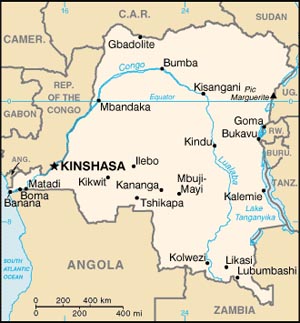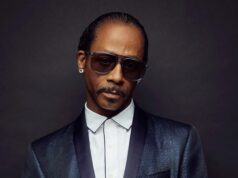| Geography Location: Central Africa. Bordering nations–Angola, Burundi, Central African Republic, Republic of the Congo, Rwanda, Sudan, Tanzania, Uganda, Zambia. Area: 2.345 sq. km. (905,063 sq. mi.; about the size of the U.S. east of the Mississippi). Cities: Capital–Kinshasa (pop. 8 million). Regional capitals–Bandundu, Bukavu, Goma, Kananga, Kindu, Kisangani, Lubumbashi, Matadi, Mbandaka, Mbuji-Mayi. Terrain: Varies from tropical rainforests to mountainous terraces, plateaus, savannas, dense grasslands, and mountains. Climate: Equatorial; ranges from tropical rainforest in the Congo River basin, hot and humid in much of the north and west, cooler and drier in the south central area and the east.People Nationality: Noun and adjective–Congolese. Population (2010 est.): 68 million. Annual population growth rate (2008 est.): 3.24%. Ethnic groups: Approximately 250 African ethnic groups; the Luba, Kongo, and Anamongo are some of the larger groups. Religions: Christian 70% (Catholic 50%, Protestant 20%); Kimbanguist 10%; other sects and traditional beliefs 10%; Muslim 10%. Language: Official–French. National languages–Lingala, Swahili, Kikongo, Tshiluba. Education: Literacy (2008 est.)–French or local language: 55% (women), 76% (men). Schooling (2007 est.)–none 21%, primary 46%, secondary 30%, university 3%. Health (2007 est.): Infant mortality rate–92/1,000 live births. Life expectancy (2008 est.)–51.3 yrs.Government Type: Republic; highly centralized with executive power vested in the president. Independence: June 30, 1960 (from Belgium). Constitution: The D.R.C. has had numerous constitutions, constitutional amendments, and transitional constitutions since independence. The currently operative constitution was approved by 84% of voters in a December 2005 referendum and officially promulgated in February 2006. Branches: Executive–President is head of state. Cabinet is appointed by the ruling party in the parliament. Prime minister is elected by the parliament. Legislative–The 500-member lower house of parliament was elected in July 30, 2006 national elections. Provincial Assemblies elected the Senate in October 29, 2006 elections, and provincial governors in early 2007. Judicial–Supreme Court (Cour Supreme). Administrative subdivisions: Eleven provinces including the capital city, Kinshasa. Political parties: President Joseph Kabila’s party is Parti du Peuple pour la Reconstruction et le Developpement (PPRD). Two main coalitions, the Alliance pour la Majorite Presidentielle (AMP) and the Union pour la Nation (UN), respectively represent President Kabila and former Transitional Vice President Jean-Pierre Bemba.Economy GDP (2009): $10.82 billion. Annual GDP growth rate (2009): 2.7%. Per capita GDP (2009): $171. Natural resources: Copper, cobalt, diamonds, gold, other minerals; petroleum; wood; hydroelectric potential. Agriculture: Cash crops–coffee, rubber, palm oil, cotton, cocoa, sugar, tea. Food crops–manioc, corn, legumes, plantains, peanuts. Land use: Agriculture 3%; pasture 7%; forest/woodland 77%; other 13%. Industry: Types–processed and unprocessed minerals; consumer products, including textiles, plastics, footwear, cigarettes, metal products; processed foods and beverages, cement, timber. Currency: Congolese franc (FC). The U.S. dollar is also used as legal tender. Trade: Exports (2009 est.)–$3.787 billion. Products–diamonds, cobalt, copper, coffee, petroleum. Main partners–EU, Japan, South Africa, U.S., China. Imports (2009 est.)–$5.254 billion. Products–consumer goods (food, textiles), capital equipment, refined petroleum products. Partners–EU, China, South Africa, U.S. Official debt (est.): $13.5 billion. |










